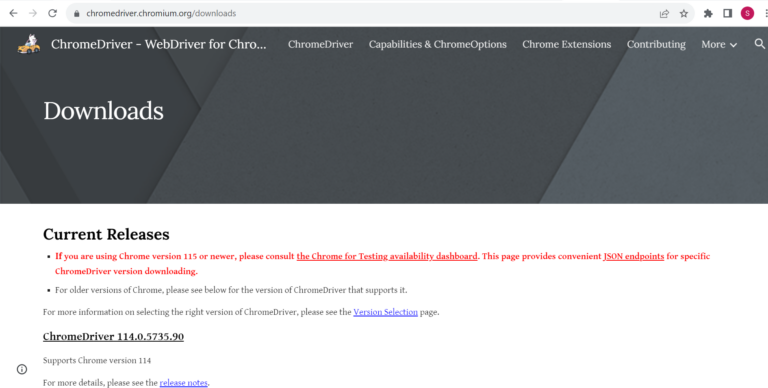It’s no wonder that Selenium ChromeDriver has remained a strong choice for the quality engineer and developer community in automated web testing. At the core of many Selenium test suites lies ChromeDriver, the enabling component that connects your automation scripts to the Chrome browser. While it works wonders, certain performance bottlenecks and flakiness can show up when the suite grows.
Whether you are a novice to Selenium or are a player in enterprise-scale testing, taking steps to optimize ChromeDriver for speed and stability will lead to faster delivery, lower costs, and greater test accuracy. This comprehensive guide delves into proven techniques, practical strategies, and modern tools, such as LambdaTest, to optimize Selenium ChromeDriver.
Understanding Selenium ChromeDriver
Selenium ChromeDriver is an independent server created by the Chromium team that serves as an intermediary between Selenium WebDriver commands and the Google Chrome browser. It uses the WebDriver protocol, which allows automated test scripts implemented in languages such as Java, Python, or C# to interact with Chrome as if they were an actual user. From button clicks and form filling to page navigation and content validation, ChromeDriver converts Selenium commands into native browser operations in real-time.
Essentially, ChromeDriver is what allows testers and developers alike to automate tests on Chrome in a controlled, repeatable, and highly scalable way. Furthermore, now it is invaluable for cross-browser testing, regression testing, and validating the deployment of complex web applications across various environments.
Finally, the reliability of the automation results is greatly influenced by the need to match the version of ChromeDriver with that of Chrome installed on your local machine or test infrastructure. In fact, automation frameworks today have transformed the lives of teams, enabling them to obtain feedback faster with enhanced test accuracy.
While it performs well out of the box, the real challenge begins when your test suite scales. Tests can become slower, more unstable, and harder to manage. That’s where optimization comes in.
Strategies to Improve Selenium ChromeDriver Speed
In an environment where fast feedback and quick iterations are key to agile development, optimizing test execution speed becomes essential. Speed is vital not only to save time but also to keep development cycles short. Here are several enhanced strategies to improve speed without compromising reliability:
- Keep Tests Short and Independent: Your tests must be as modular and focused as possible. Do not write massive monolithic test automation scripts; break them down into smaller, manageable pieces. This will not only aid in faster execution but also help when debugging a failure of the test.
- Remove Redundant or Repetitive Actions: Tests can be significantly slowed down by actions repeated too often, such as useless navigation, needless assertions, or excessive initialization code. Regularly audit your test scripts and remove any redundant steps so that each action serves a distinct purpose on its own.
- Take Advantage of Parallel Test Execution: Parallel test execution should be utilized instead of sequential test execution. Execution time can be reduced to a great extent with the concurrent running of tests, especially in cloud platforms like LambdaTest. There are several testing frameworks that support parallelism out of the box – TestNG, JUnit, and Pytest, to name a few.
- Reuse Browser Sessions When Applicable: Instead of starting a new browser instance for each test, consider reusing browser sessions where possible. If your tests share a similar setup or navigation, reusing browser instances can significantly reduce the time spent on initialization.
- Use Explicit Waits Over Static Delays: Avoid using fixed Thread.sleep() statements, as they add unnecessary delays. Instead, rely on explicit waits, which allow the browser to move forward as soon as the condition (such as an element becoming visible or clickable) is met.
- Group Related Tests for Efficient Execution: Organizing tests into logical groups can help avoid repetitive setup/teardown cycles. For instance, tests related to user login or checkout flow can be grouped together, reducing the need for separate browser instances or redundant actions.
- Leverage Headless Browsers: Running tests in headless mode (where the browser runs without a graphical user interface) is faster and less resource-intensive. Headless browsers can run tests significantly faster than browsers with a visible UI, particularly in CI/CD pipelines.
- Use Fast Selectors in Test Scripts: Ensure that the locators used in your tests are as fast as possible. Use CSS selectors, which tend to be quicker than XPath expressions. Opt for simple attributes like id, name, or class, which can be selected quickly.
- Use Browser Profiling Tools: Profiling with tools such as Chrome’s DevTools can help one spot slow elements, scripts, or network requests that are hindering speed in tests. Profiling should give you specific bad spots that you can work on.
- Optimize Page Load Time: If your script for testing is dependent on page loading events, verify the optimization of pages. Load time can greatly increase while optimizing pages or removing unnecessary assets, such as huge images or very heavy scripts, thereby improving the test speed overall.
- Utilize a Distributed Selenium Grid: In the case of large test suites, it is a great idea to use a Selenium Grid or a cloud-based Selenium Grid (e.g., LambdaTest) to distribute the load and simultaneously execute tests across multiple nodes for faster execution and higher throughput.
- Test on Multiple Browser Versions and Environments Simultaneously: Instead of running tests one browser at a time, you will run tests on many versions of Chrome, Firefox, Safari, etc., on various operating systems, at the same time; this will help you in verifying compatibility and thereby speed up feedback in the testing process.
Techniques to Improve Test Stability
Stability is equally important to ensure that your Selenium tests are consistent, reliable, and maintainable over time. Unstable tests can cause confusion, increased debugging time, and undermine trust in your automation suite. Here are additional strategies to improve the stability of your Selenium ChromeDriver tests:
- Use Reliable and Resilient Locators: The primary cause of flaky tests is unreliable locators. Always use stable locators such as unique IDs, data-test-id attributes, or ARIA labels. When the UI is dynamic, ensure your locators are as specific as possible.
- Implement Effective Error Handling: The use of such features as screenshot capturing, detailed logging, and logging of error messages should facilitate the identification of any problems encountered by a failing test. In addition to the above, retry logic can help cope with failures that arise due to transient conditions (e.g., network timeouts, slow page loading).
- Keep ChromeDriver and Browser Versions in Sync: Version mismatches between ChromeDriver and the installed version of Chrome can cause failures. Always ensure that your version of ChromeDriver matches the browser version. Using tools like WebDriverManager can simplify version management and reduce errors due to version incompatibility.
- Externalize and Parameterize Test Data: Hard-coding test data hard coding is a bad practice that decreases reusability and flexibility for your tests. Externalized test data (like CSV, JSON, or a combination of CSV, JSON with databases) and test case parameterization can help edit test data without altering the test code.
- Implement Synchronization Techniques: Inefficient synchronization between the browser and the automation script can lead to flaky tests. Explicit waits, combined with ExpectedConditions, help ensure that the elements are ready for interaction. Avoid relying on implicit waits or static waits that can cause unnecessary delays.
- Regularly Clean Up Test Data: Test scripts that leave test data or objects behind can cause test failures on subsequent runs. Ensure that your tests clean up their environment (e.g., logging out, clearing session data) to maintain test isolation.
- Monitor and Review Test Execution Logs: Regularly review the execution logs generated by your tests to identify patterns of failure. Logs help you understand where failures occur (e.g., network delays, slow server responses) and what adjustments you can make to improve stability.
- Implement Auto-Retry Mechanisms: For tests that are prone to occasional flakiness, such as those interacting with slow servers, consider adding retry mechanisms. This can be done by catching exceptions, waiting for a fixed time, and attempting the action again, reducing the need to manually rerun failed tests.
- Use Docker Containers for Test Environments: Running Selenium tests in Docker containers gives you a well-isolated, consistent, and controlled environment for testing. It helps minimize the failures owing to environmental disparities between developer machines, CI pipelines, and production environments.
- Test with Real User Interactions: The automation code sometimes works and fails to capture conditions during the actual user’s interacting with the page. So make sure that your automation mimics the user’s real interaction by simulating mouse movements, clicks, and keyboard actions instead of emulating these interactions with simple clicks or key presses.
- Avoid Over-reliance on JavaScript-heavy Web Elements: Web applications using a lot of JavaScript for rendering dynamic content may lead to timing issues during testing. If possible, reduce reliance on JavaScript-heavy elements or use techniques to interact with the application through the backend or direct API calls, improving stability.
- Use Visual Regression Testing: Combining Selenium tests with visual regression testing tools (e.g., Percy or Applitools) can help catch UI-related issues that aren’t easily detected through standard element assertions. This improves the overall stability of tests by verifying that UI components appear as expected across different browsers and devices.
- Review and Refactor Test Scripts Periodically: Over time, Test scripts tend to gather technical debts and now it is high time to refactor your test scripts by cleaning redundant code and simplifying locators, and ensuring good modularity as this goes a long way in improving maintainability in what it will cost to ensure that all the historical tests will not lead to increasing risk of instability.
- Implement Test Prioritization: Not all tests can be equal. Upon giving priority to certain test executions, such as running critical tests (for instance, tests for main workflows, or for high-risk features), one can ensure that the critical tests will be made stable and run first. Use TestNG for tagging and prioritizing your tests based on importance for execution.
Leveraging LambdaTest to Improve Speed and Stability
Cloud testing platforms like LambdaTest offer modern testing infrastructure with powerful features designed to optimize Selenium ChromeDriver tests. LambdaTest is an AI-native test execution platform that lets you run manual and automated tests at scale across 3000+ browsers, OS combinations, and 10,000+ real devices.
Here’s how LambdaTest can amplify your testing efforts:
- Cross-browser and device coverage: Access a wide variety of browser versions, screen resolutions, and OS combinations without maintaining physical devices.
- Parallel test execution at scale: Run multiple tests at once, helping you reduce overall test cycles and feedback time.
- Real-time debugging and logs: View test execution videos, console logs, and screenshots to diagnose failures faster.
- Headless browser testing: Run tests in headless mode across virtual machines for even faster execution.
- CI/CD integrations: Seamlessly plug your Selenium suite into Jenkins, CircleCI, GitLab, or any popular CI/CD tool.
- Support for multiple frameworks and languages: Whether you’re using TestNG, Pytest, Cucumber, or JUnit, LambdaTest supports them all, offering flexibility and ease of integration.
By delegating your test executions to a cloud grid, all constraints that have to do with infrastructure are removed, ensuring consistent performance in every environment.
Final Thoughts
Optimizing Selenium ChromeDriver testing is a multidimensional event that involves the test design, environment setup, and tool integration; it is not just writing good scripts- it is building a sustainable, scalable, and maintainable automation ecosystem.
When done in the right way, you will end up spending less time debugging flaky tests and more time speeding up quality software delivery. Strategies discussed-from smart test structuring and effective waits, to leveraging a cloud platform like LambdaTest, dramatically improve both speed and stability.
Be consistent, audit frequently, and at all times customize automation practice to suit the continuously evolving demands of your project.






